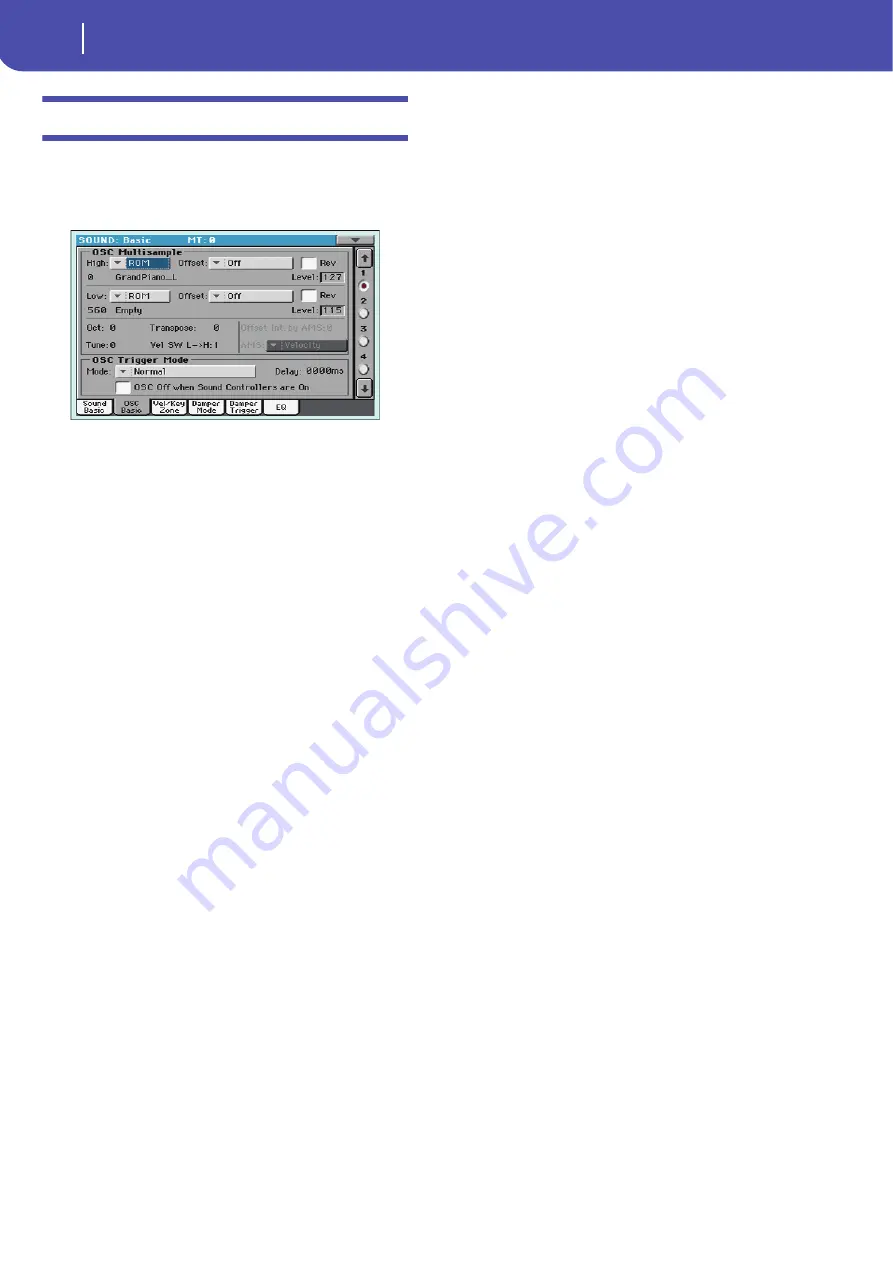
112
Sound Edit operating mode
Basic: OSC Basic
Basic: OSC Basic
The multisample(s) on which the Sound will be based can be
selected here for each of the sixteen oscillators. Each oscillator
can use 1 or 2 multisamples, each one assigned to the High or
Low layer.
OSC Multisample
High/Low Bank/Num
Use these parameters to select a different multisample for each of
the High and Low layers. You can use velocity to switch between
the two multisamples. Offset and Level can be adjusted indepen-
dently for the High and Low multisamples.
The High and Low pop-up menus is where you select the bank
(ROM or RAM), while the numeric field under it is for selecting
the multisample inside the selected bank. The Sound name
appears on its right.
The multisample you select for the High layer will be triggered
by velocities higher than the value of the “Velocity Multisample
Switch Low-High” parameter (see page 112). If you do not wish
to use velocity switching, set the switch to a value of 001, and
select only the High multisample.
ROM
The Factory bank. The Factory area of the inter-
nal memory contains 560 different multisamples
(preset multisamples), supplied by Korg as stan-
dard.
RAM
RAM multisample, read from the RAM. These
are user-loaded multisamples.
Note:
If you create a new Sound based on a RAM
multisample, the RAM samples must be loaded
from the internal HD or from a connected USB pen
driver.
In case samples are not loaded, no sound will be
heard, even if the Sound can be selected and its
name appears in the display.
Note:
Each multisample has an upper note range limit, and cannot
produce sound when played above that limit.
Offset
These parameters specify the point where the multisample(s)
will begin to play. For some multisamples this parameter will not
be available.
Off
The sound will start from the beginning of the
multisample waveform.
1st…6th The sound will begin from the offset location pre-
determined for each sample.
No Attack
The initial portion of the multisample is ignored.
AMS
Activates the Alternate Modulation Source (see
below).
PseudoRandom
(Only works when more than one Offset point is
available in the multisample).
Randomly selects
one of the available Offset points (including
Attack and Off).
Level
These parameters specify the level of each multisample.
0…127
Multisample level.
Note:
Depending on the multisample, high settings of this parame-
ter may cause the sound to distort when a chord is played. If this
occurs, lower the level.
Octave
Use this parameter to adjust the pitch of the selected oscillator in
octave units. The normal octave of the multisample is “0”.
-2…+1
Octave transposition.
Transpose
Use this parameter to adjust the pitch of the selected oscillator in
semitone steps over a range of ±1 octave.
-12…+12
Transposition in semitones.
Tune
Use this parameter to adjust the pitch of the sample in one-cent
steps (a semitone is 100 cents) over a range of ±1 octave.
-1200…+1200
Fine-tune value in cents.
Velocity Multisample Switch Low-High
This is the velocity value dividing the High and Low layers for
the selected oscillator. Notes struck harder than this value will be
played by the High multisample.
AMS / Offset Intensity by AMS
(Only available when the AMS option is selected in the “Offset”
parameter.)
Alternate Modulation Source for the Offset. See
“AMS (Alternate Modulation Source) list” on page 136.
When the “Offset Intensity by AMS” parameter has a positive
value, the selected Offset point will depend on the AMS value.
For example, if the selected AMS is the Velocity, when playing
softly you will select the Off or 1st Offset, when playing loudly
you will select the 6th or No Attack Offset.
When the “Offset Intensity by AMS” parameter has a negative
value, the selection will happen in reverse (higher-numbered
Offsets will be selected before the lowest-numbered ones).
OSC Trigger Mode
OSC Trigger parameters are used to set the condition to trigger
the selected Oscillator. For example, a Normal Oscillator will
Summary of Contents for PA 600 QT
Page 1: ...Reference Guide ENGLISH OS Ver 1 0 1 E ...
Page 2: ......
Page 8: ...4 Table of Contents ...
Page 9: ......
Page 196: ...192 MIDI Playing another instrument with Pa600 ...
Page 197: ......
Page 327: ......
















































